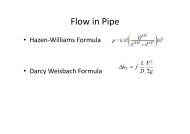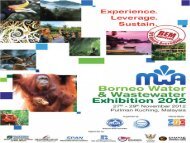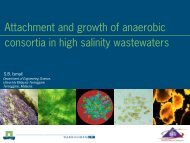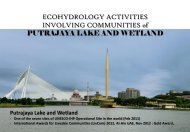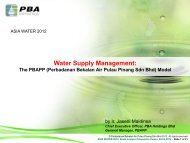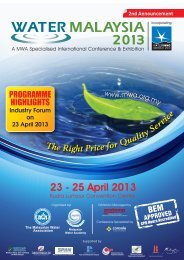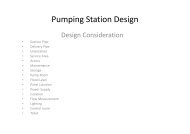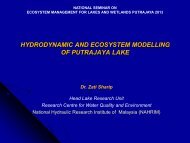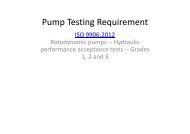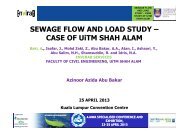Exclusive InterviewWM Exclusive Interview with<strong>Mr</strong>. Mohamad Sabari bin Shakeran,General Manager, Kuching Water BoardIr. Mohamad Sabari graduated in1986 with a Bachelor of Science(CivilEngineering) Degree from the MemphisState University Tennessee,USA. Heobtained his Post Graduate (EnvironmentalImpacts Assessment) Degree at MurdochUniversity,Western Australia in 2002, andhis Master of Science (Environment) Degreeat Murdoch University, Western Australia in2004WM: Could you tell us something aboutyour background? For example, howlong have you been involved in the waterindustry?<strong>Mr</strong>. Sabari: I reported for duty with JabatanKerja Raya <strong>Sarawak</strong> (JKR) as the AssistantExecutive Engineer on 26th May 1987.My first posting was to the WaterworksSection, JKR Kuching Divisional Office asthe section head-in-charge of the WaterSupply Authorities in Kuching Division;during this period, Samarahan Division wasstill part of Kuching Division.Over 25 years of working experience inJKR <strong>Sarawak</strong>, some 17 years of my careerare related to the water supply industryinvolving with the planning, design,project management, water resourcesmanagement, and setting up of hydrometricstations, as well as monitoring of waterresources stationed in Water Supply Branchin JKR Headquarters and divisional office.The balance of work experiencesincludes managements, supervisionsof projects related to civil works (roads,buildings, bridges) and operation &maintenance works of government assetsin the JKR divisional offices. I was promotedto the post of General Manager of KuchingWater Board (KWB) on the 5th August2011.WM: What is the situation like of the watersupply in Kuching under the Kuching WaterBoard (KWB)?<strong>Mr</strong>. Sabari: KWB is currently producingan average of 430 MLD of drinking waterto a supply area of 730sq km and serving apopulation of about 680,000. The meteredconsumption is at 290 MLD and thus, theresultant NRW is about 32.6%. The numberof services in 2011 totals 147,147 thatexpand across the industry, commercial anddomestic consumers.KWB is managed by a total of 574 staffwith 21 of them in the Professional andManagerial Group while the rest of 553 areunder Support Group.WM: What challenges do you have toface in the distributions of water supply inKuching? How was the water situation likewhen you first joined the service and whathave you achieved so far. Are you happywith the results?<strong>Mr</strong>. Sabari: The high NRW of 32.6% is myimmediate concern and I am confidentthat with the available technologies andestablished industrial practices, KWB canreduce the NRW to a manageable level.About 6 months into my tenure as theGM of KWB, I established two additionalNRW teams in January this year with theaim to facilitate the leak reduction. Withthree NRW teams actively involved now, Iam confident in reducing the NRW by 3-4percent by year-end.WM: What are the projects that you haveundertaken during your tenure?<strong>Mr</strong>. Sabari: I managed to witness thepractical completion of our 100 MLDModule 8 in September 2011. I am nowembarking on upgrading of our Batu KitangTreatment Plant in meeting the increasingdemand from Kuching City, JKR Kuchingand Samarahan Division supplied by KWB.In meeting the distribution demand ofthe greater Kuching and JKR, a total of 7new reservoirs, some with a capacity of 180ML, will be built before 2030. Studies arebeing conducted now on the constructionof reservoirs at Demak <strong>Lau</strong>t, 9¾ mile and7th Mile in the near future.In ensuring our delivery capability, theconstruction of a 1,000 mm. diam. pipelinking Samajaya Free Industrial Zoneand Module 8 is in progress. In additionto that, new pipes will be laid to link 7thmile network to 9¾ mile and to EntingganReservoir in Kota Samarahan.Despite the availability of raw waterresource, concern on the sustainability of itssupply requires strategic attention. At times,the current safe yield of Sungai <strong>Sarawak</strong> Kiriis subjected to raw water shortage duringthe prolonged dry spell. The initiative bythe State Government to build Bengoh damsolely for the purpose of raw water storagecould eventually reduce the potential riskof raw water shortage during incoming drymonths.WM: One final Question. What are yourfuture plans in order to upgrade furtherthe water situations in Kuching?<strong>Mr</strong>. Sabari: Amongst the major activitiesthat will become the road map to the futuredevelopment of KWB’s operation is toembark in the 5 Year Strategic Plans. Themain thrust of the strategic plans encompasstransformation of organisation structure,enhance human capital, strengtheningcustomer service and promote efficientoperation & maintenance of the watersupply system.The activities and outputs derive fromthis strategic planning will be the roadmapfor KWB performance in heading to thefuture. ICT and Asset Management will alsobe another important focus to leveragethe potential high performance of KWB tosatisfy the water consumers.Master of Science(Environment)Murdoch University,Western AustraliaPost Graduate(EnvironmentalImpacts Assessment)Murdoch University,Western AustraliaBachelor of Science(Civil Engineering)Memphis StateUniversity, Tennessee,USA2004200219864 WaterMalaysia
Special FeatureTransforming the Landscape of <strong>Sewerage</strong>Industry in Malaysia– The Role of R&D and InnovationsThe sewerage industry in Malaysia hasevolved at a rapid pace over the last2 decades. The sewage treatment trendhas changed from basic system such asseptic tanks in the 60’s to mechanisedtreatment plants during the presentdays.This evolution has taken place largelydue to stakeholders’ demand for cleanerand safer environment for the publicas well as an increased awareness forsustainable future. Ever since then, thesewerage industry, has been facing customerand regulatory requirement thatare increasingly more stringent as civilsociety becomes more sophisticated anddemand for a healthier environment tolive in.Besides, the sewerage industry alsoneeds to keep abreast with the generalenvironmental issues that may arise directlyor indirectly from its day to dayactivities. This includes river pollution,waste management problems, sewageflooding, water borne diseases, soil contamination,groundwater contamination,global warming and climate change.Additionally, it’s important to notethat Malaysia needs its own set of basicdata, know-how and resources for efficientand effective sewerage managementas the weather, climate, ambientcondition, the normal microflora andmicrofauna as well as the diet and eatinghabits of its people differ from thatof other countries from where the seweragetechnologies are sourced and usedin Malaysia.Research & DevelopmentWithin this context, research and development(R&D) including new innovationsis much needed in Malaysia toimprove sewage treatment capabilitiesand thus enhance environmental healthof our water resources whilst contributingtowards sustainable development.Apart from sewage treatment, researchis also needed for the improvementof the collection systems (e.g. useof local in-pipe treatment and effectivemicroorganisms; use of fibre optics andtrench sharing technology; new generationof efficient pumping systems includingequipment and products).Hence, the primary objective of theR&D is to provide knowledge that ensuresreliable, consistent, satisfactory,affordable and efficient sewerage servicesto enhance quality of life and to contributeto economic growth and improvepublic health status of the communityand country.In line with this, the secondary objectivesare to develop appropriate methods,approaches and technologies forimproving the management of sewerageservices; provide appropriate, innovativeand practical solutions for managementof sewerage services; develop applicationsfor improved treatment of sewageand sludge and improved processes forenabling increased reuse thereof; andimprove health, economic and environmentalconditions while supporting thedevelopment of appropriate technologiesand socially focused managementpractices related to sewerage management.In order to be focused and structuredin undertaking R&D to meet therequirement for the sewerage sector,it is imperative that key areas for R&Dactivities are identified. This includesoptimisation of sewage treatment performanceand sewage sludge treatment,recovery and reuse of sewage waste byproducts; energy saving and generationof renewable energy from sewage;improvised sewage collection system;environmental management and socioeconomicdemands.Paradigm Shift“The key thrust of the R&D should triggera paradigm shift in the sewerageindustry from the Victorian technologythat utilises large resources, land areas,materials and resources with little emphasison resource recovery to the applicationof emerging technologies suchas Biotechnology, Nanotechnology andGreen Technology. Additionally principlesof social science and economicsshall be applied across in the researchactivities so that practical and cost effectivesolutions are identified throughthe research,” says Ir. Hj. Haniffa Hamid,General Manager, (Planning & Engineering),Indah Water Konsortium Sdn Bhd(IWK).“IWK had undertaken and facilitatedmore than 100 local R&D projects focusingon operational efficiencies whichWaterMalaysia 5



